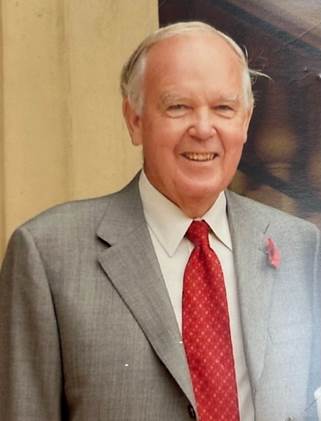Honouring Sir Bob Reid
Honouring Sir Bob Reid, Chairman Emeritus of Benjamin Franklin House
1 May 1934 – 28 May 2025
Sir Bob Reid successfully led large projects including as Chair and CEO of Shell UK, as Chair of British Rail, as Deputy Governor of the Bank of Scotland and much more. But he was masterful at a small one as well – one with immense historical and contemporary importance – Benjamin Franklin House.
Lady Joan Reid, his brilliant wife (18 October 1932 – 10 November 2017), was on the Council of the Royal Society of Arts, which celebrates Benjamin Franklin as its first international member, when discussion of 36 Craven Street, neighbour to the RSA, came up. The House in the late 1990s was derelict and needing a path forward. She suggested to Sir Bob that he pick up the reins.
And so he became founding Chairman of Benjamin Franklin House in 1997 leading with foresight, vision, patience and kindness. He opened doors to funding, gave strategic direction and was unwavering in his encouragement and support to the House team.
In the early days of the effort to conserve and realise the House’s potential as a dynamic museum and educational facility that makes real Franklin’s life in London and legacy for citizenship, diplomacy, letters, invention and more, a gala at the Science Museum was held to garner attention and support for the project. The then new US Ambassador was due to attend but at the last minute, with some 200 guests in situ, word came that he would not be present. Sir Bob took the news with his customary aplomb and declared there was no reason to panic, the event would somehow “be better” for the late change. In taking the stage, Sir Bob, who lost an arm as a nine year old while helping in his father’s butcher shop but still managed to have a 4 handicap in golf, said with characteristic humour, “I have lost many things in my life. My arm, many golf balls, and a number of papers, but I have never lost an Ambassador.” The room erupted in laughter and set the tone for an outstanding evening.
After becoming Chairman Emeritus of Benjamin Franklin House in 2008, Sir Bob went on to serve on the board of ICE, owner of the New York Stock Exchange, London Electricity, Avis Europe and until just a few years ago, the board of Diligenta Limited, a Tata company. He was the first chancellor of Robert Gordon University and received honourary degrees from Heriot-Watt University and London Southbank University. He also served at the helm of many other charities including Learning Through Landscapes for 19 years and the Foundation for Young Musicians for 28 years. He received his knighthood in Queen Elizabeth’s 1990 Birthday Honours.
He adored his family, which encompassed sons and partners Doug and Sharon, Paul and Isobel, Mike and Clare, and their children and several great grandchildren.
Born in Cupar, Fife, he studied political economy and modern history at St Andrews University, where he met his historian wife, who had been in the first group of Fulbright students to study in the United States. Marrying in 1958, the year Sir Bob joined Shell, they lived around the world including in Brunei, Nigeria, Thailand and Australia.
Benjamin Franklin House has a Lady Joan Children’s Author in Residence and will offer a first Reid Prize for Children’s Literature in 2025.
He published his autobiography, No Condition is Permanent; Risk, Adventure and Return: The Business of Life in 2022. In it he notes with humility, “the fascination of leadership is the opportunity it provides for working with people,” and “people’s dedication to continued achievement is what makes working with them so motivating….”
Thank you Sir Bob for your enduring wisdom and leadership. You will long be remembered for all you did to make Benjamin Franklin House what it is today and tomorrow – a place that brings history and innovation to life.



